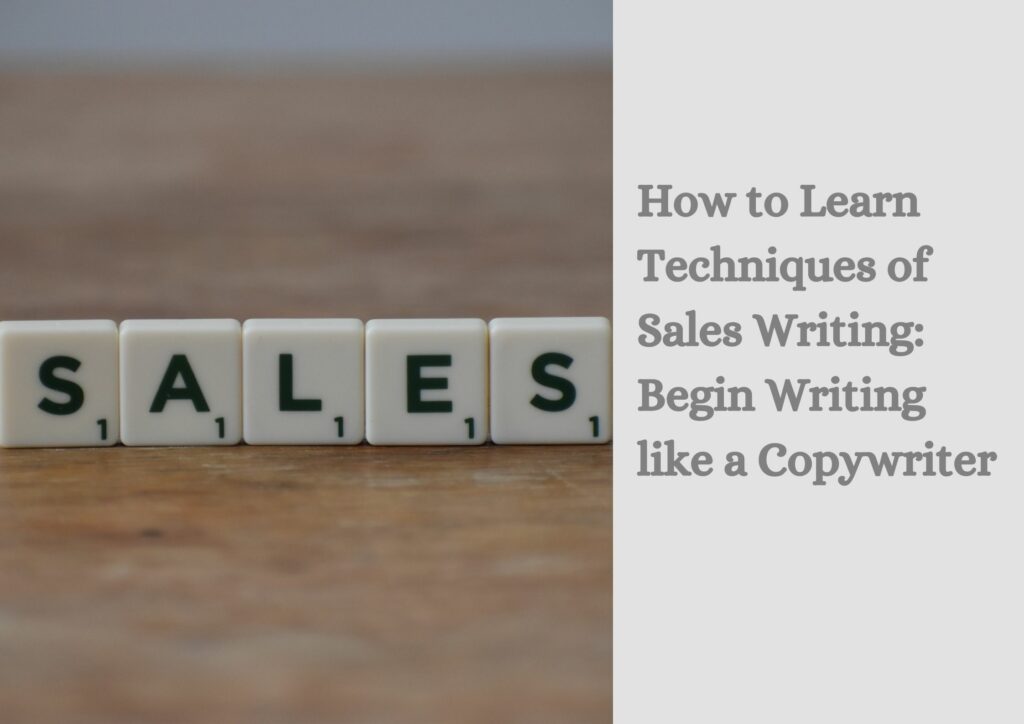Sales Copywriting
Sales writing isn’t a talent that everyone has, but it should be for product marketers in particular; sales writing affects audience engagement, which in turn affects direct sales. When it comes to selling a product to your target audience, 91 percent of B2B marketers employ content marketing, which means there’s a lot of competition. With this in mind, you’ll want to make sure your writing skills are on point to help you stand out from the pack of copywriters.
Eric Moeller, Director of Product Marketing at Sage, agreed, saying, “Sales copywriting necessitates a very unique set of talents that I really believe any marketer should possess. Most marketers, in my opinion, haven’t put as much effort into their sales copywriting abilities as they could, and they plainly need to be more effective.”
The simple answer is that these tactics aren’t based on personal experience, folklore that hasn’t been thoroughly investigated, or any so-called “best practices.” Our study has revealed that the correct response is frequently the most paradoxical. You may be employing the most common option when you choose to follow best practices, but this is not always the case. Inherently, best practices are “lagging practices.” It might take years to designate anything as a best practice, by which time it has become ubiquitous. On the other hand, science is objective and timeless. It is only concerned with the purchasers and their actions. Science isn’t deceitful. Even though these sales strategies appear strange and contradictory, behavioural research studies have proven that they are the greatest way for selling to B2B decision-makers.
Difference Between Sales Copy Writing and Content Writing
The art of sales writing is the creation of compelling content that both informs and persuades visitors to become clients. It might be in the form of email sales writing, webpage sales writing, or any other type of sales writing that aims to convert visitors into clients. This type of copy is distinct from other types of writing and is sometimes referred to as “copywriting“. And, unlike content writing (as shown in this post and every other blog you’ve ever read), copywriting focuses on concision. It’s stating as much as you can in as little words as possible. As a general rule, content authoring is what seals the sale. Copywriting brings it to a close.
The Significance of this Difference
More marketing communications are consumed by your customers than ever before. According to some research, consumer exposure to commercials across all media has increased by 120 percent in the previous decade. Basically, if you have to nail one of them as an entrepreneur, it’s your copywriting, not your content creation, that has to be perfected. Otherwise, if the copy you put on your sales page is merely a passing idea, it will blend in with the other 9,999 messages your clients receive on a daily basis. So, if you recall nothing else from this post, keep this in mind:
- The copy you include with your items is equally as crucial as the images, payment methods, and other features you employ to entice people to buy. It’s also not only a fact that applies to small company owners. Professional marketers have always understood the importance of a skillful word in their campaigns. It’s one of the reasons why writing is the most outsourced marketing activity, even surpassing design work. Outsourcing copy tasks has also had positive results for several firms.
One of the UK’s most well-known cab networks, for example, was able to increase organic traffic by 15% by updating the text on existing sites and building new, copywriter-guided landing pages. Similarly, by refining the language on their CTAs, content, and landing pages, HubSpot witnessed a nearly 100 percent boost in conversions.
At this point, it may appear that this is more of a pitch for hiring a copywriter. It’s not the case. You can discover amazing writers on Upwork who are willing to work with you, as well as other experts who can handle your business duties to outsource, if you can afford one — but the objective isn’t to hammer on the necessity for a professional. Rather, it’s to highlight one basic truth: words have an impact on your bottom line. Quite a bit.
But, contrary to popular belief, copywriting isn’t difficult. People like myself rely on our skill to flip a well-turned word to make ends meet. It certainly isn’t. This isn’t an instance of imposter syndrome raising its head. You don’t need to hire someone like me to write outstanding copy for your goods; all you need is the appropriate combination of skills, tools, and a little bravery.
Why Copywriting is the Best Sales Writing Approach?
Because all writing is persuasive, even if you’re not selling something, the techniques and tactics of the copywriter’s profession—a craft centred on sales and marketing—are equally valuable in business writing. Isn’t it true that anything you’re writing serves a purpose? You do not write sales copy for your words to vanish into thin air. You’re not writing only to appear active. You’re not (or shouldn’t be) writing to whine about a last-minute meeting reschedule. You’re writing because you need to get something done. Someone has to be persuaded of something. Your writing at work must convince, much way a copywriter produces an email or a web page to persuade someone to buy something. Even if you believe you’re writing to inform rather than convince, you’re still persuading and convincing the reader that your knowledge is trustworthy and worthwhile.
To help you become a more persuasive writer, here are a few simple techniques to incorporate sales writing into your business writing skills to increase your writing at work and boost your confidence:
Write Sales Copies with these Techniques

Some of these techniques are tried-and-true, learnt and repeated by every writer in the profession, while others are a little further off the beaten road based on my own experiences. So read on if you want to learn how to write a good sales copy and follow along or jump right to easy-button mode.
1. Identify Your Objectives:
This is maybe the most fundamental guideline of copywriting and sales writing. After all, if you don’t know what you’re trying to accomplish, you won’t be able to write properly since you won’t know what to say or how to say it.
What do you intend to accomplish with your writing? It’s possible that you have a variety of objectives. Is it your purpose to spread knowledge? How do you sum up a conversation? To arrange a meeting? To indicate apprehension? To show off your abilities? In order to obtain information? To make a case for an increase in the budget?
Before you start writing, be sure you know what you want to achieve.
- PRO HINT: What is the key message you want to convey when crafting a headline for your online copy? Concentrate solely on one subject. Describe what you do. Alternatively, describe how your product or service will help your readers.
2. Employ a Problem => Solution framework:
Remember when you were in school and had to write essays? The problem is outlined first, and then your argument is explained. The same pattern applies to sales copy: first, you expose or imply a problem that the customer has, and then you explain why the product is the answer. The level of subtlety you use depends on the tone and style of your site, but if you don’t mind being straightforward, you may start by setting a situation to pique your reader’s interest.
You’ve finally secured reservations at that trendy new restaurant, but you’re short on cash.” This not only sets the scene for the problem, but it also establishes a personal connection with the customer.
- PRO HINT: Make sure to include all of your product’s characteristics in your sales text — be as thorough as possible. Then think about the problem that each feature solves.
3. Use Both the Second and First Person Pronouns in your Writing:
We are instructed at school to avoid all styles of writing except the third person. Even implying a first-person pronoun may have you on the wrong end of a red ink pen, and for many individuals, that’s a bad thing. The idea of integrating yourself or your reader directly in text is obscene, especially if you developed a love for academic writing like I did. But it’s a belief you’ll have to let go of sooner rather than later, both second and first-person writing are essential for copywriting. They connect the user to the words’ ordinarily cold, lifeless pixels, breaking down the inherent boundaries that exist between a creator and their audience. When I speak with you, the emotional effect of what I’m saying has a better chance of connecting, however when the user is merely referred to as “the user,” they become hazy and distant.
In fact, first-person should be your primary choice for CTAs on your product pages and embedded buttons (see what I did there?). CTAs written in the first person convert up to 90% better than those written in the second. But first, a word of caution regarding this strategy. While using second and first person language has been demonstrated to improve brand affinity and increase customer engagement, it only works in societies where collectivism is low.
If your target audience is predominantly from a collectivist society, proceed with care and cautiously test the waters. Otherwise, the significance of a well-placed “you” should not be overlooked.
- PRO HINT: Learn how to engage your reader with powerful words.
- Keep your copy focused on the reader. Use the term you more than your company’s or product’s name.
- Allow the reader to visualize themselves using your new product.
- Make use of strong impressionable language.
4. Instead of Adverbs and Adjectives, Use Verbs and Nouns:
Consider the following two descriptions:
…to make adventurous people’s life simpler.
…to help travelers better their lives.
The main building blocks of language are verbs and nouns, with adjectives and adverbs recommended for secondary descriptors (what kind of adventurer are you?). Adjectives and adverbs should not be wholly ignored; instead, think of them as spices, with verbs and nouns serving as the meat and potatoes. With descriptive adjectives and adverbs, a little goes a long way, and the less you use, the greater effect the ones that remain will have.
The adverb “extremely” is the most common stumbling block to this strategy. Is your product “very simple” to use? It’s been dubbed “effortless.” Is it “distinctive” from other products? Then there’s “unique” or “rare.”
5. Include Subheadings and Bullets:
Readers are intimidated by large blocks of text, which might lead to bouncing. When images can’t be used to break up the text, bullet points and subheadings can be used instead.
In truth, bullets and subheadings can be used for more than just breaking up text:
• They make information more digestible.
• They make it easy to navigate a page.
• They improve the aesthetics of a page.
• They provide need-to-know information to visitors who do not want to read.
Bullets are very helpful for describing product characteristics. Because most customers won’t read every line of product text, bulleting the features makes them easier to find and comprehend without wasting their time. Keep in mind the Serial Position Effect while drafting bullets, which is another gift from science to marketing. When presented a list, people are more likely to recall the first and final items, according to the Serial Position Effect. In sales writing, this implies putting the most important elements first and last.
PRO HINT
All prospective buyer objections should be brainstormed and written down. Ask your consumers and prospects if you’re unsure. Additionally, be certain that your sales copy answers each objection.
6. Keeping it Short and Simple can be very Effective:
Do you have any idea what people lack? Time, If people have to use a dictionary or decoder to comprehend your website, they are more likely to abandon it than to persevere. That’s why, as much as I adore terms like “axiom,” I don’t use them when writing for clients, and I definitely don’t encourage them to anybody attempting to sell something. Because, while it’s a good word, it’s not really readable. (If you’re curious, axiom stands for self-evident truth, and no, I don’t know how to say it either.) Readability is important. Experts recommend that your material be readable at a grade eight level (pre-highschool for those outside the United States). By the way, this is true regardless of where your audience is from. The global average reading score is securely at “level 2,” with the top-performing countries just scraping the edge of “level 3” reading.
More information about the levels and what they denote can be found here (unfortunately, it’s not really legible), but the idea is this:
• Readers with a level 2 reading level can make low-level inferences, integrate multiple pieces of information, perform basic compare and contrast tasks, and identify document structure.
• Readers with a level 3 reading level can derive meaning across large swaths of data, disregard irrelevant information, and perform high-level analyses.
Keep in mind that even if your audience is a voracious reader, they may not want to read at that level on your sales pages.In reality, most people prefer to read books that are a few grades below their current level of ability. Hemingway App is the champion for assessing and modifying the readability of writing if you need a little help.
It’s a simple plug-and-play editor that highlights tough phrases and provides a fast glimpse of your copy’s grade level. Make your copy as basic as possible.
It may not be the most engrossing read (though I believe Marc shown that brief material can be), but it will be simple for your clients to scan. They can spend more time reacting to what you’re saying if they don’t have to spend time figuring out what you’re trying to communicate. That can only be a good thing, as that is likely “buy now.”
- PRO HINT: It’s easy to read short sentences. Simply chop large sentences in half while editing. Also, don’t be concerned about punctuation errors. Be courageous. And, But, or Because are all good ways to start a sentence. On average, try to keep your material around 12 words each phrase. Try writing with us.
7. Get the Information you need to Localize:
Even if you’re the most persuasive salesperson ever, how convincing can you be if your target buyer doesn’t speak your language? Do you lose out on the sale because you speak the same language but have a significant cultural difference? Only 25% of internet users speak English, which is a large market you may get into if you localize your content.
Localization entails more than merely translating your sales copy for a particular market. For example, most Americans dislike formality, yet most Hong Kong entrepreneurs consider being informal to be disrespectful. Localization training guarantees that you secure these corporate accounts and, as a consequence, your goods and pitches become more convincing.
Localization entails a number of phases, the first of which is the creation of market-specific content. This will serve as both content marketing and SEO optimization. You should also think about changing your product to better fit local demand. Don’t rely on Google translate to convey your message; you won’t come off as convincing.
8. Anchoring- A Method of Revolving around a Product:
The last strategy is anchoring, which involves presenting a thing in the most beneficial setting for a sale. For example, $200 may seem like a lot for a pair of shoes… until you consider that high-end designers’ shoes cost roughly $500 on average. When compared to others, $200 looks like a steal — and it is.
When developing the graphics of an e-Commerce site, anchoring items to make them look more valued by contrast works just as well. The order in which goods appear in a search, as well as the ones you highlight on the home page, will all “anchor” your shopper’s perception of “normal.”
This effect might be amplified by your sales copy. Don’t be hesitant to explain why your product is valuable, such as the expenses of materials or how much money the consumer would save during a current deal. When it comes to sales writing, your words have complete authority on the situation.
- PRO HINT: How can a new product be compared to an older model? Include all of the reasons why your new model is superior to the old one. To emphasize the disparities, use actual figures. When selling an upgrade, make sure to include all of the additional features. Emphasize how new it is. Use phrases like “all-new,” “totally new,” and “absolutely new.”
How to Make a Perfect Sales Email

Let’s take a closer look at each of these five elements to make the perfect sales email:
1. Be Sure to Include a Subject Line:
Keep the subject line of your sales email short and intriguing. Remember that your purpose is to excite your reader’s curiosity, not to seem like a used-car salesperson. Here are some sales representative examples:
Jerry suggested I contact you.
- Suggestions for [something essential to them]
- Inquiry into [recent trigger incident].
- A question concerning [their objective].
- Some thoughts on [blog post title].
- Have you considered [idea / suggestion]?
Furthermore, avoid using “spammy” terms in your subject lines at all costs. Some instances are as follows:
- Final
- Reminder
- Sale
- Tempting
- Specials
- Complimentary
- Help
- Donation
- Don’t
- Exciting
- Unique
- Discount
- Solution
- Partner
- State of the art
Pro Tip: A/B Test Your Subject Lines
Take a sub-section of your prospect list, this must consist of around 50 or more emails to be statistically significant. Then split these subsets of emails into two groups. Next, send both subgroups of emails identical content but with two different subject lines. After collecting results, you should choose which group’s email had the highest open rate and then use that as the subject line for the rest of your list.
Target an open rate of 30% to 50%. The more prospects open your email, the better are your chances of getting a response.
2. Create a Powerful Opening Line:
When it comes to the first line of your sales email, stay away from “Hello, my name is…”
Instead, start with something more memorable, such as a conversation with your reader. Some instances are as follows:
- I took note of you…
- The term [mutual connection] was used…
- I saw that we were both…
- I really enjoyed your article on…
- I’d want to congratulate you on…
3. Include an Informative Body Copy:
The body text of your sales email should add value by linking your company to your prospect. Avoid generic value propositions like “We assist online marketing businesses grow lead generation by 400% while proving ROI to their clients with ease.”
“They must show their clientele a return on their investment.”
Inquire about your prospect’s goals in relation to the study you’ve done. Some instances are as follows:
- How would you wish to enhance your plan, if at all?
- Is [benefit to them] a current priority for you?
- Do you have any unsolved [topic] questions?
- Are you looking for a lifestyle business or global dominance?
- Are you the only one who thinks this way?
- Is this how it’s always been?
- Is it wonderful to have it, or does it have to happen?
- How would you react if you were in my shoes
- Was it all your idea?
4. Include a CTA in the Final Copy:
A compelling conclusion to your sales email provides a call to action for recipients. To elicit a decisive response, try closing with one of the following questions:
- Do you have time on your schedule to talk about it?
- Have you given the proposition any extra thought?
- Please let me know what, if any, next steps make sense.
- Do you have 10 minutes tomorrow to catch up?
- Is it reasonable for us to speak? If not, who would be the ideal person to speak with?
- Do you have any other queries that I can answer?
- Do you have a 30-minute call availability on [day and time]?
Please let me know if [business objective] is a current or future priority for you.
Do I have your permission to close your file if you aren’t interested?
5. Include a Professional Significance:
A sales email signature should not be a source of cliché inspiration or a source of distraction. Instead, use these recommendations for email signatures:
- Keep it brief, straightforward, professional, and consistent with your brand.
- Include your phone number in case you need to be contacted.
- Include a link to your preferred online profile (e.g., LinkedIn or Facebook) so that recipients may interact with you.
- Stay away from pictures and quotations at all costs.
The Key is Research and Practice
Finding the correct materials to help you get started on whatever you’re writing about is the most difficult aspect.
However, being confident in what you’re saying is the greatest approach to encourage others to listen to you. Make sure you’ve done a lot of research on the material you’re about to create.
The next step is to incorporate these strategies into your sales copy, and the best way to do so is- to just do it. Anyone can only learn anything correctly by putting what they’ve learned into practice. What better approach to hone your sales writing skills than to get right in?
Eric Moeller provided some background on how he got started, saying:
“I became a little obsessed with looking at the different books that people were mentioning in these podcasts.”As you read a bunch of these books, you’ll see that they all talk about a lot of the same themes, but there are a lot of distinct tiny tips and tactics you can take up from each one.”
Common Mistakes to Avoid

There are several errors in sales writing that are frequently missed yet readily avoidable. It’s easy to assume that your reader understands what you’re talking about while selling a product; but, employing too much industry jargon can be off-putting and alienating to a buyer.
Do your market research as a first step.
Learn about your target market’s vocabulary when discussing certain items and use it to inform how you communicate back to them.
We asked Eric whether he’d seen any typical blunders in corporate marketing, and he offered the following advice:
“I believe that a lot of the time, when we’re creating sales copy, we want to talk about what we know rather than what the client or prospect cares about. It’s simple to say, Hey, we’re introducing features a, b, and c, and that’s the nice thing about this new version, when a new release is released. That’s focused on the incorrect thing; this is what we’re interested in, but what we actually want to know is what the prospect is interested in. I believe that if you have done your homework in terms of creating user personas and buyer personas […] if you truly understand it, you will be able to identify the pain points as well as the goals of your clients.”
“There’s a tendency to put a lot of focus on, let’s keep iterating these things. However, if we don’t get to the heart of what is a really unpleasant situation for the client, we may continue to have poor market performance.”
Many of the mistakes we make when producing marketing material are due to a lack of understanding of our target audience, inaccessible language, or a lack of personalization. All of these things make the reader feel alienated.
Again, we’re attempting to bridge the gap between the more compelling and effective ‘business to human’ strategy and the more fascinating and successful ‘human to human’ approach. Get into your client’s shoes!
Takeaways from the Blog
So-called “best practices” won’t stand up in the Customer Deciding Journey when it comes to the variety of purchase choices you need to impact. The inquiries, actions, and motives of your consumers shift from one moment to the next.
If you really want to develop your sales skills, you’ll need to learn a variety of sales strategies like these, as well as situational awareness to know when and how to adjust to different situations.
Some of the most significant characteristics of your business are the language on your website and product pages. Keep this in mind if you’ve been putting off generating a product or underselling yourself as a writer:
- Sales writing, also known as copywriting, is the most outsourced marketing activity, so you’re not alone in thinking it should be done by someone else.
- From the minute your clients appear on your site or page, strong copywriting seals the sale and establishes a relationship with them.
- However, despite its frightening nature, writing for your website isn’t difficult; all you need is a little practice and the correct combination of skills and tools.
- Begin by including first- and second-person pronouns in your writing. It may appear odd at first, but trust me when I say you’ll appreciate how it improves brand recognition. Also, don’t get too caught up in each punctuation mark. While brushing up on the foundations of the language you’re writing in is a good idea, authors seldom have impeccable grammar on their own.
- Above all, pay attention to your copy’s readability. It should be straightforward, straightforward, and simple to read.
So this was my take on how to learn and apply the sales writing techniques effectively!
I hope you are excited to give space to these strategies in your sales guidebook!
Let me know in the comment section below!



